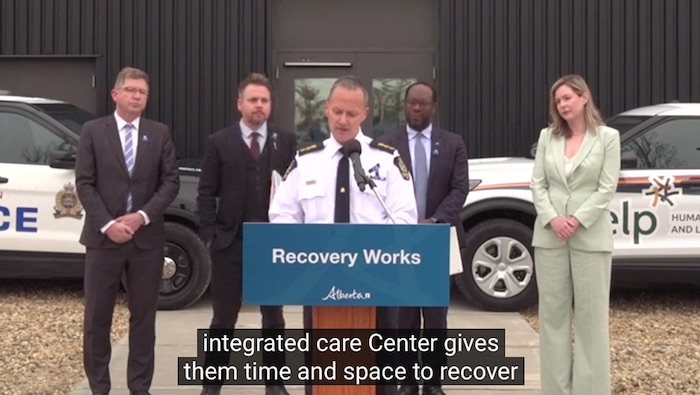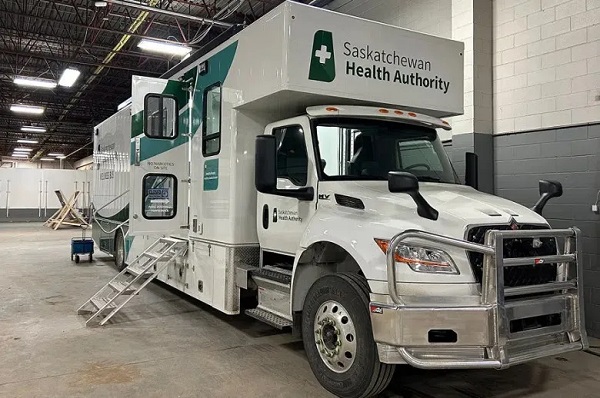Addictions
Province providing $17 Million to double addictions and mental health supports for people in custody

Helping people in need, keeping Edmonton safe
Alberta’s government is partnering with the Edmonton Police Service (EPS) to help address the addiction crisis by connecting more people to much-needed supports.
Alberta’s government is continuing to take action to keep communities safe while treating mental health and addiction as health care issues. Through Budget 2023, an investment of $17 million over three years will double the number of Human-centred Engagement and Liaison Partnership (HELP) teams in Edmonton and provide recovery-oriented health supports to people in EPS custody.
“We are continuing to take a fair, firm and compassionate approach towards addressing addiction and mental health issues while keeping communities safe. Police are vital partners in addressing the complex social challenges facing Edmonton, and our government is proud to be partnering with them to help connect Albertans to the supports that they need.”
“Edmonton police are serving on the front lines of the addiction crisis and have an important role to play. This funding brings together health professionals, community partners and police through partnerships that share a common goal: helping more people get well and pursue recovery while keeping our communities safe.”
“As MLA for Edmonton-South West, I am pleased to see that our government has allotted much needed funding to create more HELP teams to support the Edmonton Police Service. The new support will help address the public safety, mental health and addiction crisis in the city. The safety of the people of Edmonton is paramount. No one should be afraid to walk alone in our streets. We all share a common goal of providing adequate supports while keeping our communities safe”.
This funding includes:
- $3.5 million for 12 new social navigator positions and two team leads, which will double the number of HELP teams in Edmonton
- $2 million for eight new social navigator positions to support the EPS Divergence and Desistance Branch
- $2.4 million for eight mental health therapists to support Edmonton’s 911 Dispatch Centre and EPS officers over the phone with clinical expertise
- $6.3 million to add the following health professionals:
- two full-time health care practitioners, two paramedics, two recovery coaches and 12 community safety officers at EPS Downtown Division
- two paramedics at EPS Northwest Division
- $2 million for equipment, training, administrative and other related costs
- $858,000 in one-time capital funding for six new HELP team vehicles and facility upgrades
These initiatives are part of ongoing efforts led by the Edmonton Public Safety and Community Response Task Force to improve public safety while treating addiction and mental health as health care issues. These efforts also include tripling the number of Police and Crisis Teams (PACT) in Edmonton to support people experiencing a mental health crisis.
Expanding outreach teams in Edmonton
Like many large cities, Edmonton has been hard hit by the addiction crisis, and this is especially evident in the downtown area. Expanding outreach teams in Edmonton will help respond to an urgent need to connect people struggling with mental health and addiction to critical services and mitigate social disorder.
“Community wellness and community safety go hand in hand. The HELP team has shown impressive results, and we are proud to continue building on their good work and introduce more integrated health services for people in police custody. We are grateful for the support of the government. These actions are important steps in responding to the complex social issues facing our city.”
“Additional support for the HELP teams is positive news for Edmonton. This investment is key in breaking the cycle, by shifting the focus on mental health and addiction away from enforcement and directing individuals to programs and services that can help them live with hope and dignity.”
Alberta’s government is doubling the number of HELP teams in Edmonton. These teams pair police officers with social navigators from local community organizations who can help Albertans access recovery-oriented supports. The province is also providing funding to add social navigators to the EPS Divergence and Desistance Branch, which works with individuals who most frequently interact with the health and justice systems, and to place AHS mental health therapists in Edmonton’s 911 Dispatch Centre and to have mental health therapists available to support EPS officers over the phone with clinical expertise.
Providing addiction and mental health support in police custody
Police officers frequently respond to calls related to addiction and mental health. By offering a range of services and supports for people in police custody, Alberta’s government can support Albertans with complex addiction and mental health challenges while improving public safety for everyone.
People detained on a public intoxication charge will be assessed and provided options for treatment and support in a secure environment at the Edmonton Police Service Downtown Division. This location is close to both the downtown core and Chinatown, which are areas of Edmonton where significant public safety concerns have been identified by the city, local businesses, business associations and Edmontonians. Health professionals will offer medical support, connect clients with other social and mental health and addiction supports, and provide referrals to programs like the Virtual Opioid Dependency Program, which provides same-day access to life-saving medications.
In December 2022, Alberta’s government established two cabinet task forces to bring community partners together to address the issues of addiction, homelessness and public safety in Calgary and Edmonton. The two Public Safety and Community Response Task Forces are responsible for implementing $187 million in provincial funding to further build out a recovery-oriented system of addiction and mental health care. The initiatives being implemented are part of a fair, firm and compassionate approach to keeping communities safe while treating addiction and mental health as health care issues.
Budget 2023 secures Alberta’s future by transforming the health care system to meet people’s needs, supporting Albertans with the high cost of living, keeping our communities safe and driving the economy with more jobs, quality education and continued diversification.
Quick facts
- Health services staff at the EPS Downtown Division will be able to assess and help up to 17 people at any given time.
- This funding is part of the $63 million for initiatives that specifically increase access to addiction treatment and support in Edmonton, implemented through the Edmonton Public Safety and Community Response Task Force.
- Albertans experiencing addiction or mental health challenges can contact 211 for information on services in their community. 211 is free, confidential and available 24-7.
- Albertans struggling with opioid addiction can contact the Virtual Opioid Dependency Program (VODP) by calling 1-844-383-7688, seven days a week, from 8 a.m. to 8 p.m. daily. VODP provides same-day access to addiction medicine specialists. There is no wait list.
Addictions
New RCMP program steering opioid addicted towards treatment and recovery

News release from Alberta RCMP
Virtual Opioid Dependency Program serves vulnerable population in Red Deer
Since April 2024, your Alberta RCMP’s Community Safety and Well-being Branch (CSWB) has been piloting the Virtual Opioid Dependency Program (VODP) program in Red Deer to assist those facing opioid dependency with initial-stage intervention services. VODP is a collaboration with the Government of Alberta, Recovery Alberta, and the Alberta RCMP, and was created to help address opioid addiction across the province.
Red Deer’s VODP consists of two teams, each consisting of a police officer and a paramedic. These teams cover the communities of Red Deer, Innisfail, Blackfalds and Sylvan Lake. The goal of the program is to have frontline points of contact that can assist opioid users by getting them access to treatment, counselling, and life-saving medication.
The Alberta RCMP’s role in VODP:
- Conducting outreach in the community, on foot, by vehicle, and even UTV, and interacting with vulnerable persons and talking with them about treatment options and making VODP referrals.
- Attending calls for service in which opioid use may be a factor, such as drug poisonings, open drug use in public, social diversion calls, etc.
- Administering medication such as Suboxone and Sublocade to opioid users who are arrested and lodged in RCMP cells and voluntarily wish to participate in VODP; these medications help with withdrawal symptoms and are the primary method for treating opioid addiction. Individuals may be provided ongoing treatment while in police custody or incarceration.
- Collaborating with agencies in the treatment and addiction space to work together on client care. Red Deer’s VODP chairs a quarterly Vulnerable Populations Working Group meeting consisting of a number of local stakeholders who come together to address both client and community needs.
While accountability for criminal actions is necessary, the Alberta RCMP recognizes that opioid addiction is part of larger social and health issues that require long-term supports. Often people facing addictions are among offenders who land in a cycle of criminality. As first responders, our officers are frequently in contact with these individuals. We are ideally placed to help connect those individuals with the VODP. The Alberta RCMP helps those individuals who wish to participate in the VODP by ensuring that they have access to necessary resources and receive the medical care they need, even while they are in police custody.
Since its start, the Red Deer program has made nearly 2,500 referrals and touchpoints with individuals, discussing VODP participation and treatment options. Some successes of the program include:
- In October 2024, Red Deer VODP assessed a 35-year-old male who was arrested and in police custody. The individual was put in contact with medical care and was prescribed and administered Suboxone. The team members did not have any contact with the male again until April 2025 when the individual visited the detachment to thank the team for treating him with care and dignity while in cells, and for getting him access to treatment. The individual stated he had been sober since, saying the treatment saved his life.
- In May 2025, the VODP team worked with a 14-year-old female who was arrested on warrants and lodged in RCMP cells. She had run away from home and was located downtown using opioids. The team spoke to the girl about treatment, was referred to VODP, and was administered Sublocade to treat her addiction. During follow-up, the team received positive feedback from both the family and the attending care providers.
The VODP provides same-day medication starts, opioid treatment transition services, and ongoing opioid dependency care to people anywhere in Alberta who are living with opioid addiction. Visit vodp.ca to learn more.
“This collaboration between Alberta’s Government, Recovery Alberta and the RCMP is a powerful example of how partnerships between health and public safety can change lives. The Virtual Opioid Dependency Program can be the first step in a person’s journey to recovery,” says Alberta’s Minister of Mental Health and Addiction Rick Wilson. “By connecting people to treatment when and where they need it most, we are helping build more paths to recovery and to a healthier Alberta.”
“Part of the Alberta RCMP’s CSWB mandate is the enhancement of public safety through community partnerships,” says Supt. Holly Glassford, Detachment Commander of Red Deer RCMP. “Through VODP, we are committed to building upon community partnerships with social and health agencies, so that we can increase accessibility to supports in our city and reduce crime in Red Deer. Together we are creating a stronger, safer Alberta.”
Addictions
Saskatchewan launches small fleet of wellness buses to expand addictions care

By Alexandra Keeler
Across Canada, mobile health models are increasingly being used to offer care to rural and underserved communities
Saskatchewan has launched a small fleet of mobile wellness buses to improve access to primary health care, mental health and addiction services in the province.
The first bus began operating in Regina on Feb. 12. Another followed in Prince Albert on March 21. Saskatoon’s bus was unveiled publicly on April 9. All three are former coach buses that have been retrofitted to provide health care to communities facing barriers to access.
“Mobile health units are proven to improve outcomes for people facing barriers to healthcare,” Kayla DeMong, the executive director of addiction treatment centre Prairie Harm Reduction, told Canadian Affairs in an email.
“We fully support this innovative approach and are excited to work alongside the health bus teams to ensure the people we support receive the care they need, when and where they need it.”
Wellness buses
Like all provinces, Saskatchewan has been grappling with the opioid crisis.
In 2023, an estimated 457 individuals died from overdoses in the province. In 2024, that number fell to 346. But the province continues to struggle with fatal and non-fatal overdoses.
In late February, Saskatoon firefighters responded to more than 25 overdoses in a single 24-hour period. Just over a week later, they responded to 37 overdoses within another 24-hour window.
Saskatchewan’s wellness buses are part of the province’s plan to address these problems. In April 2025, the province announced $2.4 million to purchase and retrofit three coach buses, plus $1.5 million in annual operating funds.
The buses operate on fixed schedules at designated locations around each city. Each bus is staffed with a nurse practitioner, nurse and assessor coordinator who offer services such as overdose reversal kits, addiction medicine and mental health referrals.
“By bringing services directly to where people are, the health buses foster safer, more welcoming spaces and help build trusting relationships between community members and care providers,” said DeMong, executive director of Prairie Harm Reduction.
Saskatoon-based Prairie Harm Reduction is one of the local organizations that partners with the buses to provide additional support services. Prairie Harm Reduction provides a range of family, youth and community supports, and also houses the province’s only fixed supervised consumption site.
The mobile model
Saskatchewan is not the only province using wellness buses. Across Canada, mobile health models are increasingly being used to expand access to care in rural and underserved communities.
In Kingston, Ont., the Street Health Centre operates a retrofitted RV called PORCH (Portable Outreach Care Hub) that serves individuals struggling with homelessness and addiction.
“Our outreach services are extremely popular with our clients and community partners,” Donna Glasspoole, manager at Street Health Centre, said in an emailed statement.
“PORCH hits the road two to three days/week and offers a variety of services, which are dependent on the health care providers and community partners aboard.”
Street Health Centre also has a shuttle service that picks up clients in shelters and brings them to medical clinics or addiction medicine clinics.
The PORCH vehicles are not supported by provincial funding, but instead rely on support from the United Way and other grants. Glasspoole says the centre’s permanent location — which does receive government funding — is more cost-effective to operate.
“The vehicles are expensive to operate and our RV is not great in winter months and requires indoor parking,” she said.

Politically palatable
Many mobile health models currently do not provide controversial services such as supervised drug consumption.
The Saskatchewan Health Authority told Canadian Affairs the province’s new wellness buses will not offer supervised consumption services or safer supply, where drug users are given prescribed opioids as an alternative to toxic street drugs.
“There are no plans to provide supervised consumption services from the wellness buses,” Saskatchewan Health Authority spokesperson Courtney Markewich told Canadian Affairs in a phone call.
This limited scope may make mobile services more politically palatable in provinces that have resisted harm reduction measures.
In Ontario, some harm reduction programs have shifted to mobile models following Premier Doug Ford’s decision to suspend supervised consumption services located within 200 metres of schools and daycares.
In April, Toronto Public Health ended operations at its Victoria Street fixed consumption site, replacing it with street outreach and mobile vans.
The Ontario government’s decision to close the sites is part of a broader pivot away from harm reduction. The province is investing $378 million to transition suspended sites into 19 new “HART Hubs” that offer primary care, mental health, addictions treatment and other supports.
Glasspoole says that what matters most is not whether services are provided at fixed or mobile locations, but how care is delivered.
Models that “reduce barriers to care, [are] non-judgemental, and [are staffed by] trauma-informed providers” are what lead more people toward treatment and recovery, she said in her email.
In Saskatchewan, DeMong hopes the province’s new wellness buses help address persistent service gaps and build trust with underserved communities.
“This initiative is a vital step toward filling long-standing gaps in the continuum of care by providing low-barrier, community-based access to health-care services,” she said.
This article was produced through the Breaking Needles Fellowship Program, which provided a grant to Canadian Affairs, a digital media outlet, to fund journalism exploring addiction and crime in Canada. Articles produced through the Fellowship are co-published by Break The Needle and Canadian Affairs.
Subscribe to Break The Needle
-

 Crime10 hours ago
Crime10 hours agoHow Chinese State-Linked Networks Replaced the Medellín Model with Global Logistics and Political Protection
-

 Addictions11 hours ago
Addictions11 hours agoNew RCMP program steering opioid addicted towards treatment and recovery
-

 Aristotle Foundation12 hours ago
Aristotle Foundation12 hours agoWe need an immigration policy that will serve all Canadians
-

 Business9 hours ago
Business9 hours agoNatural gas pipeline ownership spreads across 36 First Nations in B.C.
-

 Courageous Discourse7 hours ago
Courageous Discourse7 hours agoHealthcare Blockbuster – RFK Jr removes all 17 members of CDC Vaccine Advisory Panel!
-

 Health3 hours ago
Health3 hours agoRFK Jr. purges CDC vaccine panel, citing decades of ‘skewed science’
-

 Censorship Industrial Complex6 hours ago
Censorship Industrial Complex6 hours agoAlberta senator wants to revive lapsed Trudeau internet censorship bill
-

 Crime13 hours ago
Crime13 hours agoLetter Shows Biden Administration Privately Warned B.C. on Fentanyl Threat Years Before Patel’s Public Bombshells



